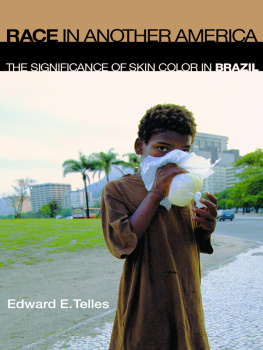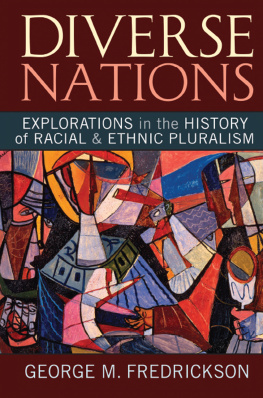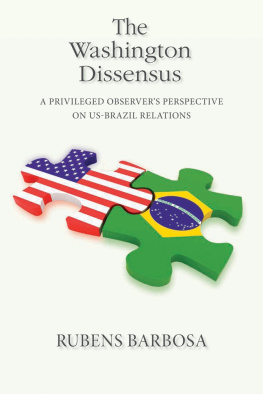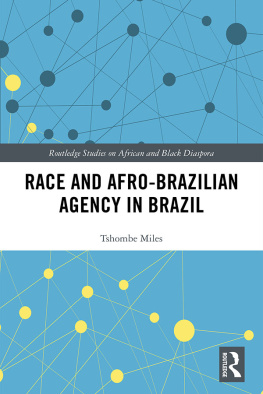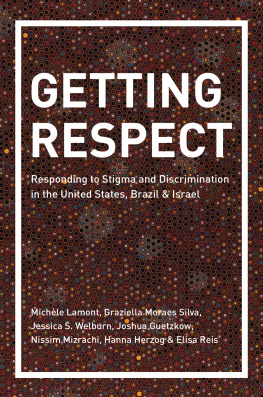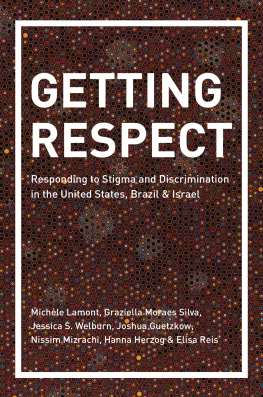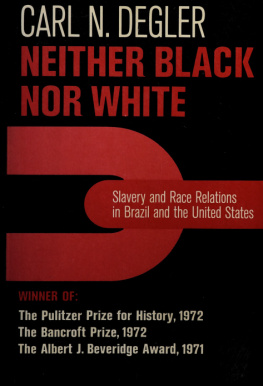
RACE IN ANOTHER AMERICA
RACE IN ANOTHER AMERICA
THE SIGNIFICANCE OF SKIN COLOR IN BRAZIL
EDWARD E. TELLES
PRINCETON UNIVERSITY PRESS PRINCETON AND OXFORD
Copyright 2004 by Princeton University Press
Published by Princeton University Press, 41 William Street, Princeton, New Jersey 08540
In the United Kingdom: Princeton University Press, 3 Market Place, Woodstock, Oxfordshire OX20 1SY
All Rights Reserved
Second printing, and first paperback printing, 2006
Paperback ISBN-13: 978-0-691-12792-7
Paperback ISBN-10: 0-691-12792-1
The Library of Congress has cataloged the cloth edition of this book as follows
Telles, Edward Eric, 1956
Race in another America : the significance of skin color in Brazil / Edward E. Telles.
p. cm.
Includes bibliographical references and index.
ISBN: 0-691-11866-3 (cl : alk. paper)
1. BrazilRace relations. 2. RacismBrazilHistory. 3. Miscegenation BrazilHistory. 4. BlacksRace identityBrazil. 5. Race discriminationLaw and legislationBrazil. I. Title.
F2659.A1T45 2004
305.896081dc22 2004044288
British Library Cataloging-in-Publication Data is available
This book has been composed in Sabon Typeface
Printed on acid-free paper.
pup.princeton.edu
Printed in the United States of America
10 9 8 7 6 5 4 3 2
CONTENTS
CHAPTER ONE
Introduction |
CHAPTER TWO
From White Supremacy to Racial Democracy |
CHAPTER THREE
From Racial Democracy to Affirmative Action |
CHAPTER FOUR
Racial Classification |
CHAPTER FIVE
Racial Inequality and Development |
CHAPTER SIX
Racial Discrimination |
CHAPTER SEVEN
Intermarriage |
CHAPTER EIGHT
Residential Segregation |
CHAPTER NINE
Rethinking Brazilian Race Relations |
CHAPTER TEN
Designing Appropriate Policies |
ACKNOWLEDGMENTS
A LTHOUGH I began writing this book in 2001, I had been thinking and writing about race in Brazil for at least a decade before that. Along the way, I have accumulated many debts to people who have influenced my thinking, many more than I can possibly thank in these pages. They range from academics to black-movement leaders to everyday Brazilians. Although I was previously interested in migration and urban poverty, I first gave the issue of race in Brazil serious thought in 19891990 when I went to Brazil as a Rockefeller Foundation Fellow at the invitation of Vilmar Faria in Population Studies at the State University of Campinas. At that time, I began reading and discussing these issues with Octavio Ianni and Elide Ruggai Bastos in Campinas and on a couple of occasions, when I could escape to Rio, with Carlos Hasenbalg and Nelson do Valle Silva. By the end of my stay, I decided I would begin analyzing the Brazilian governments newly available microdata on race.
Although I returned to teaching at UCLA in late 1990, I often returned to Brazil, mostly because of my binational relationship with Ana Maria Goldani. Of course, research reasons were also important. My research included a trip in 1993, when Ianni, Hasenbalg, Antonio Sergio Guimares, and I met to plan a national survey of racial attitudes in Brazil, and another in 1994 as a Fulbright Fellow at the Federal University of Bahia. The Fulbright posting brought me into contact with the emerging Bahian school of race relations.
From 1997 to 2000, I was fortunate to be at the Ford Foundation in Rio de Janeiro. My position as program officer in human rights gave me a birds-eye view of the tremendous changes in Brazilian racial politics, where I had tremendous access to black-movement and other civil-society leaders throughout Brazil, as well as to leading government officials and academics. I thank the black-movement leaders who often opened up their world for me to see and taught me to see their own Brazilian experience. Prominent among them were Sueli Carneiro, Ivanir dos Santos, Romero Rodriguez, Abdias do Nascimento, Sergio Martins, Edson Cardoso, Hedio Silva Jr., Maria Aparecida Bento, Helio Santos, Gilberto Leal, Joo Carlos Nogueira, Dora Lucia Lima de Bertulio, Ivair Alves dos Santos, Diva Moreira, and Samuel Vida. When I could steal time away from my bureaucratic duties, sporadic discussions with scholars at various Brazilian universities, including the Federal University of Rio de Janeiro and Candido Mendes, also enriched my understandings of Brazilian race relations. Chief among these scholars were Antonio Srgio Guimares, Livio Sansone, Joo Reis, and Joclio Teles dos Santos, my former colleagues in Bahia. I also owe thanks to a wonderful set of colleagues at the Ford Foundation in Rio de Janeiro, which included Nigel Brooke, Sarah Costa, Elizabeth Leeds, Jos Gabriel Lopez, and Ondina Leal, as well as my New York friends at the foundation, particularly Alan Jenkins and Anthony Romero. Janice Rocha, my secretary at Ford, deserves special mention for much needed help in organizing my professional life and putting up with me. Special thanks go to Brad Smith, who brought me into the Ford fold and gave me a grant upon my departure to help free up some teaching time at UCLA to work on this book and relieve the trauma of returning to academia.
Having little knowledge of formal human rights before I took my position as the human rights program officer, I owe lots to James Cavallaro, who taught me about the state of human rights abuses and the law in Brazil and internationally. He continues to help me understand human rights issues, and he and his family have become dear friends. On the leisure side, special thanks to Jim, Gabe, and other friends for engaging me on the squash and basketball courts and then toasting to those games. Special thanks go to Joaquim Barbosa Gomes, whom I befriended in Rio and who later came as a visiting scholar to UCLA. He explained the intricate Brazilian legal system, but to avoid embarrassment, I refused his invitations to play futebol. Our comradeship in Los Angeles was abruptly but happily cut short when he suddenly departed to Braslia, where he became the first negro justice of the Brazilian Supreme Court in its 174 years. My family and I are especially grateful to Eduardo and Luche Slerca and their kids for opening up their own family lives to us, helping to make Rio de Janeiro genuinely home.
While in Brazil, I was fortunate to have a National Science Foundation grant to help me with my research on Brazilian racial classification, which I began at UCLA before going to Rio de Janeiro. Although I completed the research I had planned on racial classification, the grant also helped me to begin thinking and do some preliminary research about a more ambitious project on Brazilian race relations, which would turn into this book. At the time, my own work on the project was mostly scribbling down ideas inspired by conversations with my grantees and occasional reading. Later, as I better defined my analyses, Antonio Duran helped me generate the necessary data. He was extremely knowledgeable about the intricacies of manipulating IBGE data, and his results were extremely reliable.
When I began writing the book after returning to the United States again, Sam Cohn was especially important for making me rethink my assumptions about how to produce a workable book. Walter Allen, Jorge Baln, Harley Browning, David Lpez, Peter Lownds, Jos Moya, Alejandro Portes, and Mark Sawyer read earlier versions of this manuscript and gave me valuable suggestions on drafts that I was later embarrassed to have given them. Michael Hanchard, Tom Skidmore, Roger Waldinger, and Howard Winant gave me especially detailed comments, which I greatly appreciate. Somewhere during those revisions, I translated and published a version in Portuguese, which has become a reference in Brazils current social policy debate (
Next page
